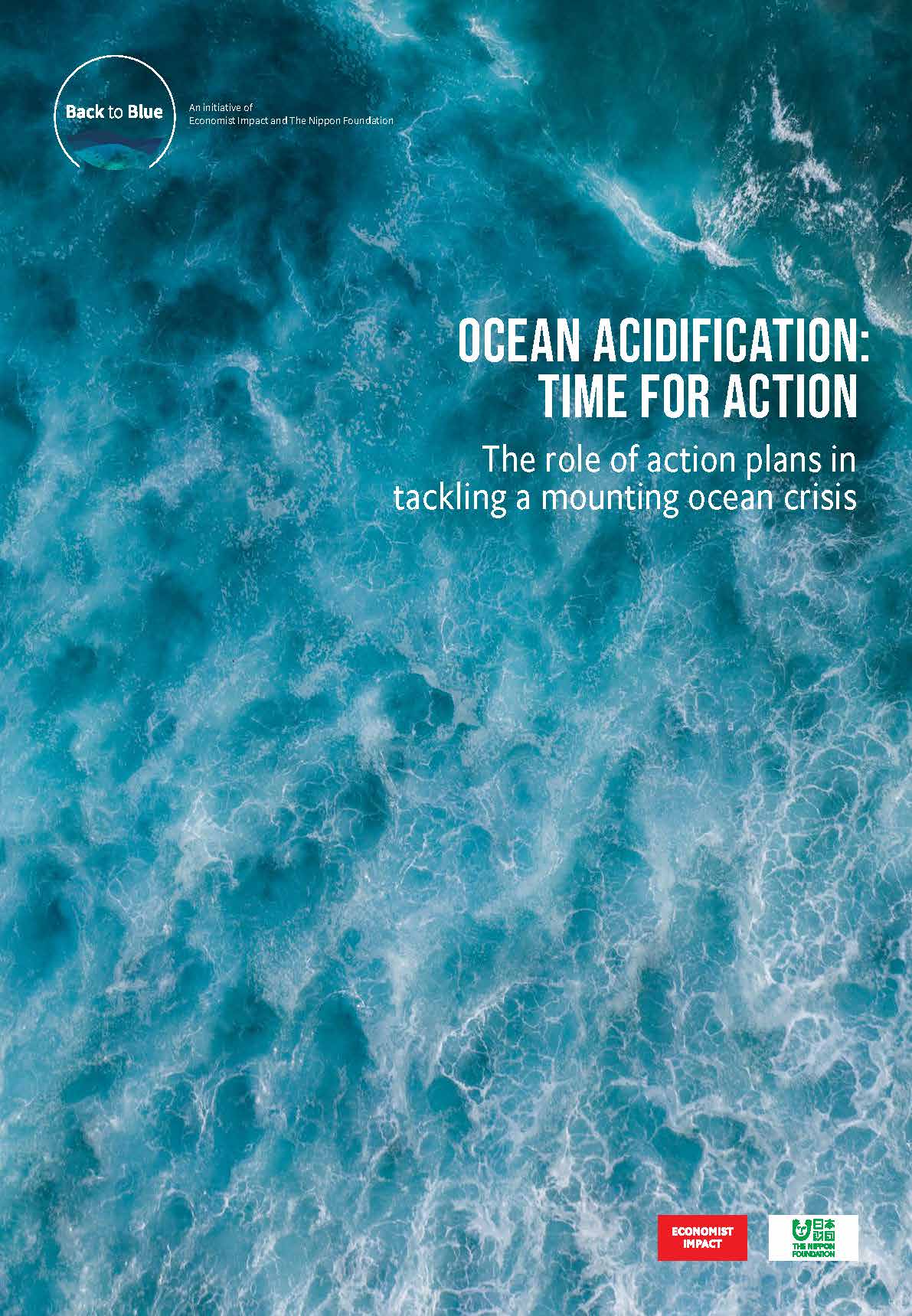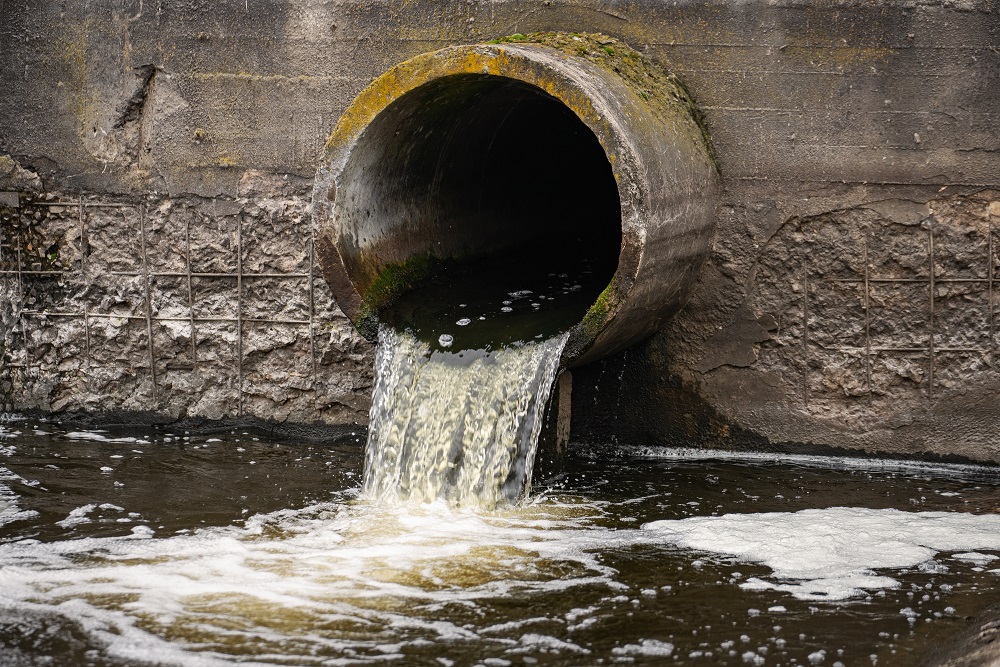About the report

Ocean acidification: Time for action is a report written by Economist Impact for Back to Blue, an initiative of Economist Impact and The Nippon Foundation. The purpose of this report is to highlight the organisational efforts being taken by national and subnational governments, as well as other organisations, to address the threat to marine ecosystems posed by ocean acidification and the role of action plans in those efforts.
Introduction
The world is waking up to the threat that ocean acidification (OA)—a rise in the acidity of seawater caused by excess carbon dioxide entering it from the atmosphere—poses to marine ecosystems and to the coastal economies that depend on them. Since OA’s damaging effects on shellfish were first documented 15 years ago, research organisations have mobilised to collect, on an ongoing basis, huge volumes of OA-related data from the world’s oceans. Based on those data, as well as data gathered in coastal areas, scientists have published a wealth of studies examining the causes and effects of OA.
Environmental advocacy groups championing ocean health, charitable foundations and intergovernmental organisations have built on this work to raise global awareness of OA, fund wider research into it and prod governments around the world to take concrete actions to combat it.

Pacific pioneers: Setting the global standard for OA
National action plans are highly desirable, but it is state governments on the US Pacific coast that have set the standard of OA action for the rest of the world to follow.
Governments, however, have been slow to rise to this challenge. Although many have voiced concerns about OA and expressed an intention to fight it through international mechanisms, at the time of writing less than a dozen have published dedicated action plans. These document specific measures governments will take—or are taking—to advance understanding and the domestic response to OA.
The experts we interviewed for this report are strong advocates for OA action plans. Measures to address OA have a vital place in wider climate change and other marine management initiatives, but a dedicated OA plan stands a better chance of cementing the ambition and commitment of a country, region or locality to actively address localised manifestations of OA and turn back the tide. And while some non-government organisations (NGOs) and science institutions have issued OA action plans of their own, none will carry as much weight as those led by governments.

National action plans are highly desirable, but it is state governments on the US Pacific coast that have set the standard of OA action for the rest of the world to follow. It is here that scientists first registered the deadly impacts of OA on marine life and the threat to coastal economies and jobs. That emergency and follow-on research findings led governments in the region to commit unequivocally to combat OA with the help of dedicated, detailed and well-resourced action plans.
In examining governments’ and other entities’ progress on mobilising against OA, this report finds that existing North American action plans offer useful examples and insights for other jurisdictions. Far from all governments will be able to base their plans on the same depth of research or call on the same resources to draft them. But by including in their plans elements such as a vision of success, timelines, assignment of ownership, and a mandate for periodic review and updating, governments can call upon more resources and put their OA action plans on a firm footing.
CONTINUE READING
by downloading the full report
Why action is vital
Ocean acidification is a growing threat to many forms of marine life and to the communities that rely on them for food, jobs and economic wellbeing. OA is a direct result of the growing carbon dioxide (CO2) emissions generated by human activity. Up to 30% of carbon released into the atmosphere each year is absorbed by the ocean, which helps to mitigate global warming. But the ocean’s ability to sequester carbon cannot keep pace with rising emission volumes.1 The result is a decline in the pH level of seawater and a rise in its acidity.
Figure 1: Ocean pH is falling
The pH level of seawater is a key indicator of ocean acidification. The pH
scale runs from 0 to 14.
Over the past century, the mean surface ocean pH level has fallen from 8.2
to below 8.1.
About half of that decline has occurred in the past 40 years – a sign that
acidification has been accelerating.
pH stripes for the global ocean (65°S - 65°N) with interannual and seasonal variability
Source: Data and timescale image from ETH Zurich
But pH is already lower than 8 in some waters, especially along some of our coasts. If global carbon emissions continue to increase at their current rate, by 2100, pH will be below 8 in most of the ocean.
Maps of sea-surface pH from the pre-industrial era to the future
Maps of sea-surface pH from the pre-industrial era to the future
Source: Courtesy of Andrew Yool. Adapted from HS Findlay and C Turley 2021. Ocean acidification and climate change. In: TM Letcher (Ed), Climate change: observed impacts on Planet Earth (Third Edition)
The detrimental impacts of acidification are more than scientific speculation. It is known to have a damaging impact on marine organisms such as oysters, mussels, scallops, crabs and other shellfish. In the Pacific North-west, large-scale losses of oyster larvae in 2007-08 were found to be tied to a rise in the acidity of hatchery waters. More recently, scientists have connected OA to weaker larval shells of Dungeness crab in waters along the US Pacific coast, negatively impacting the organisms’ growth and threatening a valuable source of aquaculture revenue. And recent reports from the north-east Atlantic region show negative impacts from increasing OA on Atlantic cod and cold-water coral reefs, critical habitats for regional fisheries.
Should CO2 emissions remain at current levels, one study has found, the concomitant rise in ocean acidification would put pteropods, bivalve molluscs, finfish and warm-water corals, among other types of marine organisms, at a very high risk of damage by the end of this century.

The threat that OA poses to biodiversity, food chains and economies is an integral part of what the UN describes as an ocean emergency. It is the reason that the UN calls for action to combat OA as part of its Sustainable Development Goals (SDGs), particularly as captured in SDG 14.3.
Call to action
The International Alliance to Combat Ocean Acidification (known as the OA Alliance)—which was launched from the experiences of the US Pacific coast response to OA—specifies six categories of action that are needed to address the challenge:
International co-operation, particularly in data collection and sharing and research capacity-building, is vital in efforts to stem OA.
But, as with other endeavours to mitigate the effects of climate change, practical actions are most effectively mobilised and implemented at national or subnational levels, and most often by governments. A handful of governments have developed action plans to guide their efforts. Many more are needed.

“OA action plans have the power to elevate the profile of OA and focus minds on addressing it,” says Steve Widdicombe, who is the director of science at Plymouth Marine Laboratory (PML) in the UK and co-chair of the Global Ocean Acidification Observing Network (GOA-ON). “An action plan signifies that the government formally recognises OA as a critical environmental challenge. And a formal plan commits the government to taking concrete actions to combat OA and support those actions with appropriate resources.” (The use of OA evidence to be routinely used in the creation of policy and legislation is a key intended outcome of the Ocean Acidification Research for Sustainability Programme [OARS], of which Mr Widdicombe is co-lead.)
Actions to combat OA, whether or not set down in a dedicated OA plan, must be seen as one important component of a country’s or region’s wider efforts to restore ocean health, according to Masanori Kobayashi, senior research fellow at the Open Policy Research Institute, an arm of the Sasakawa Peace Foundation. “A government must take an integrated, holistic approach to addressing the enormous challenges the ocean faces, including acidification, “ he says.
That approach is likely to differ from country to country depending on local circumstances, says Mr Widdicombe. “But it is vital that measures to fight OA are integrated into a country’s environmental policies and legislation," he says. “An OA action plan encourages that integration.”
OA science and research is, in many ways, still an emerging field, particularly when it comes to characterising local impacts and identifying effective solutions.
- Jessie Turner, executive director, OA Alliance
A core mission of the OA Alliance is to help governments and other entities develop action plans. Established in 2016, its 120 members include national, state and provincial governments, First Nation/indigenous group authorities as well as business associations, academic and research institutions, and other organisations. The OA Alliance is working with members to draft action plans and it has developed a toolkit and other supports to guide that process. Several plans have been completed (see below) but, according to Jessie Turner, the alliance’s executive director, its work on action plans with most governments is, in many respects, an iterative learning experience.
“OA science and research is, in many ways, still an emerging field, particularly when it comes to characterising local impacts and identifying effective solutions,” says Ms Turner. “Turning that science and information into action is even more on the cutting edge of policy development and management application. This is what governments are working to accomplish through OA action plans, and the OA Alliance is helping to share lessons learned and best practices.”
Ms Turner describes progress on building an inventory of OA action plans as organic. “The OA Alliance is a ‘coalition of the willing’. There are no legal mandates to create action plans,” she says. “Dedicating time and resources to developing them is a big challenge, for us and for governments, but it must be done.”
CONTINUE READING
by downloading the full report
About the report
Ocean acidification: Time for action is a report written by Economist Impact for Back to Blue, an initiative of Economist Impact and The Nippon Foundation. The purpose of this report is to highlight the organisational efforts being taken by national and subnational governments, as well as other organisations, to address the threat to marine ecosystems posed by ocean acidification and the role of action plans in those efforts.
To inform this report, we conducted a series of in-depth interviews with field experts. Our thanks are due to the following people (listed alphabetically by institution) for their time and insights:
- Jessie Turner, executive director, International Alliance to Combat Ocean Acidification
- Caren Braby, senior program manager, Pacific States Marine Fisheries Commission
- Helen Findlay, biological oceanographer, Plymouth Marine Laboratory
- Steve Widdicombe, director of science, Plymouth Marine Laboratory; co-chair, Global Ocean Acidification Observing Network
- Masanori Kobayashi, senior research fellow, Ocean Policy Research Institute, Sasakawa Peace Foundation
- Masahiko Fujii, professor, Atmosphere and Ocean Research Institute, University of Tokyo
This report was written by Denis McCauley and edited by Naka Kondo.
CONTINUE READING
by downloading the full report
Back to Blue is an initiative of Economist Impact and The Nippon Foundation
Back to Blue explores evidence-based approaches and solutions to the pressing issues faced by the ocean, to restoring ocean health and promoting sustainability. Sign up to our monthly Back to Blue newsletter to keep updated with the latest news, research and events from Back to Blue and Economist Impact.
The Economist Group is a global organisation and operates a strict privacy policy around the world.
Please see our privacy policy here.
THANK YOU
Thank you for your interest in Back to Blue, please feel free to explore our content.
CONTACT THE BACK TO BLUE TEAM
If you would like to co-design the Back to Blue roadmap or have feedback on content, events, editorial or media-related feedback, please fill out the form below. Thank you.
The Economist Group is a global organisation and operates a strict privacy policy around the world.
Please see our privacy policy here.



 The scourge of untreated wastewater
The scourge of untreated wastewater Slowing
the chemical tide: safeguarding human and ocean health amid
chemical pollution
Slowing
the chemical tide: safeguarding human and ocean health amid
chemical pollution Hazardous chemicals in plastics - the discussions at INC
Hazardous chemicals in plastics - the discussions at INC







